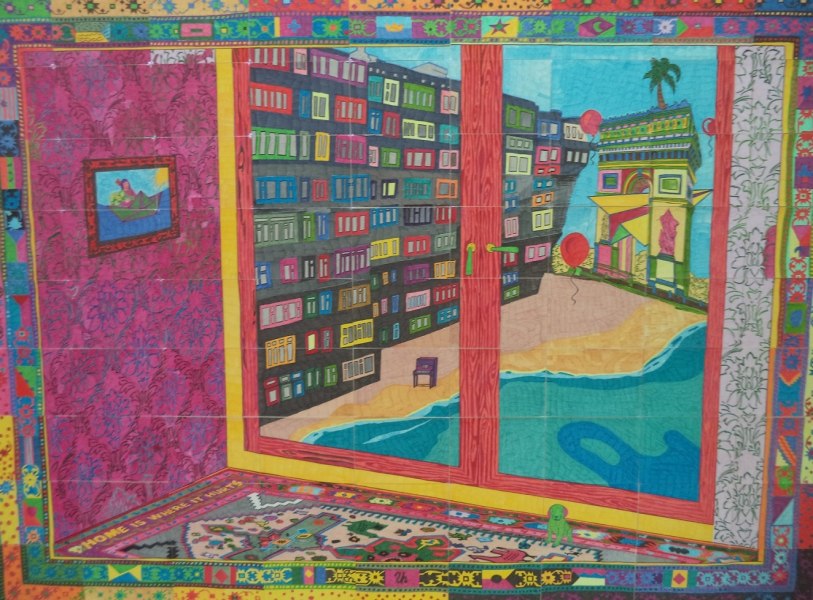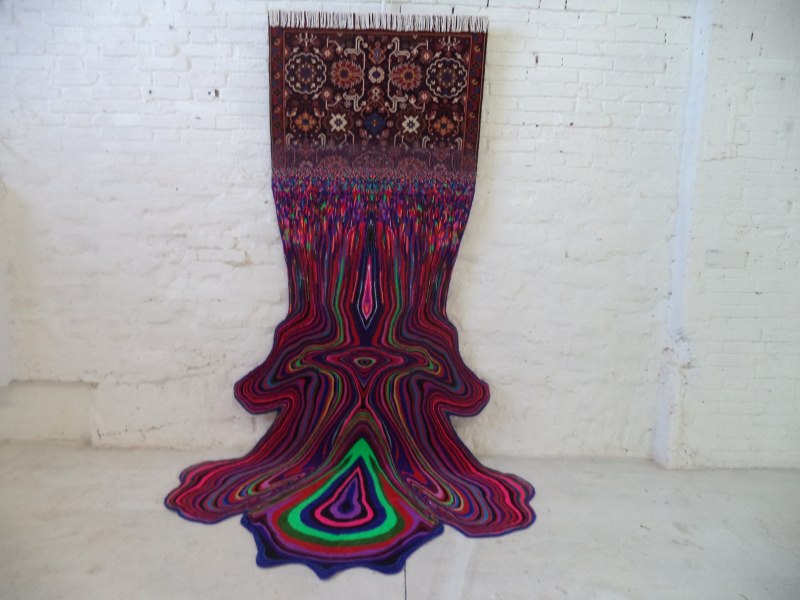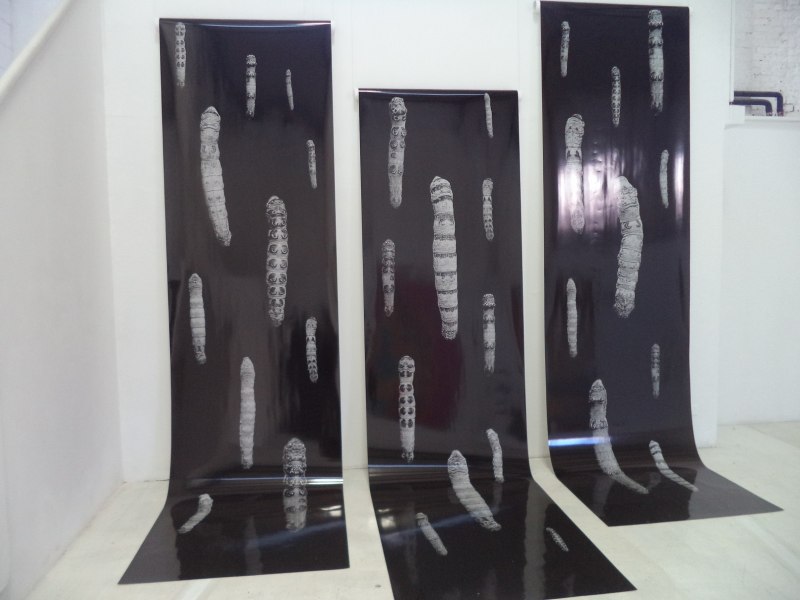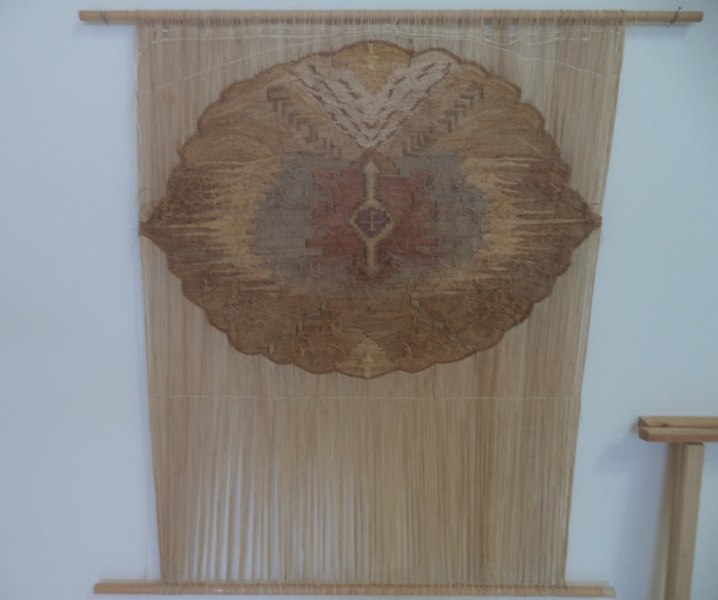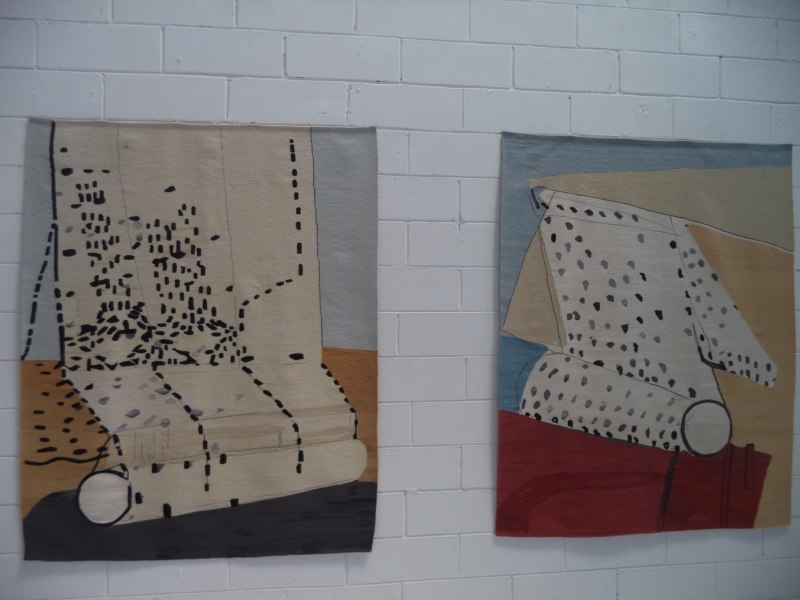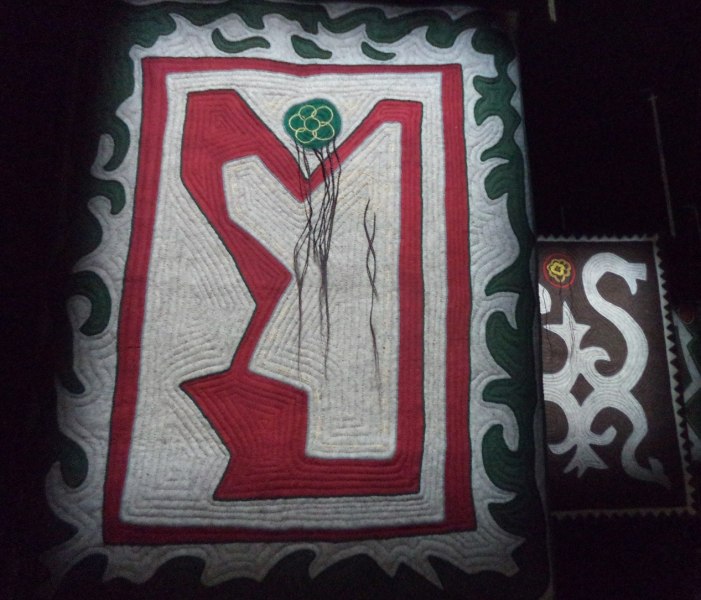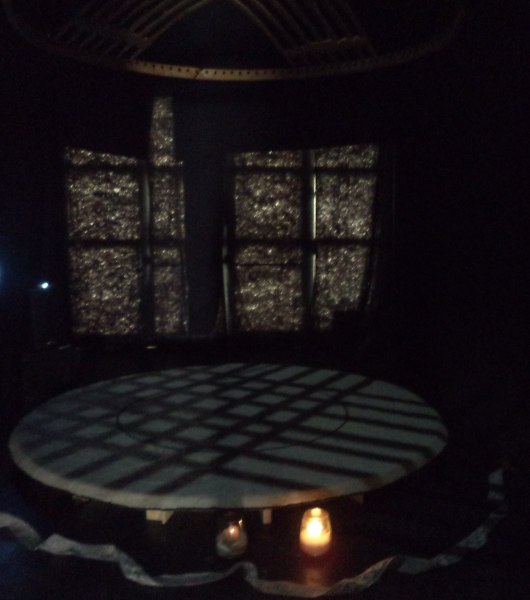Per la Biennale di Venezia, il Giudecca Art District ha scelto d’ospitare una duplice mostra: Padiglione Nazionale del Kirghizistan e Silk. Nell’insieme, emerge la rappresentazione del tessuto. Sappiamo che 10.000 anni fa fra il Caucaso e la Mesopotamia s’iniziarono ad allevare le capre e le pecore. Alla lunga, si sviluppò l’arte del tappeto. Esteticamente, ci si potrebbe chiedere come sia percepibile un “nomadismo della memoria”. La capra e la pecora sembrano animali docili, che però sanno adattarsi agli ambienti più ostili. Il nomade cerca sempre “l’altra faccia” del territorio, dopo che la prima sarà stata mitizzata. Un animale erbivoro si percepisce meglio alla vitalità “paradisiaca”, senza i piaceri… della “carne”. Il nomade deve continuamente attraversare alcuni ostacoli: montagne e fiumi su tutti. Egli vivrebbe nel “paradiso perduto” delle sue abitudini. Questa “sfortuna” può suscitarci anche tenerezza! La scoperta dell’allevamento permette all’uomo di non farsi “scappare” tutta la normalità del nutrimento, o dell’abbigliamento. La memoria serve quando tramanda. Il futuro rappresenterà l’altro “versante” del passato, mentre s’attraversa il presente. Bisogna imparare a rielaborare il mito del < Chi siamo (venendo da dove per andare, di nuovo, dove)? >. Il tappeto simboleggerebbe l’antropizzazione per una pelle che riesca a “brucare”. All’ecologista, la natura piace immergendovi se stesso. Noi “invidiamo” alla pecora la morbidezza del vello. Un tappeto funziona a miniatura per la casa perennemente in viaggio. Tutta la comodità della quotidianità si troverà… “tosata”, attraverso la dialettica con la “ruminazione” della memoria, che tende a “mitizzare” la realtà esperita. Conosciamo la “fantasia” del tappeto volante, per un nomadismo che eviti qualsiasi ostacolo in terra. Il pastore deve sempre contare i capi del proprio gregge. Egli rischia di perdere “l’eden” dell’allevamento, semplicemente perché una pecora si sbaglia ad orientarsi. Dal racconto biblico, Adamo ed Eva peccano cedendo alla carnosità della mela, cosicché trasferiscono in se stessi l’onta della nudità. Laicamente, secondo lo strutturalismo, inizia anche il mito dell’abbigliamento. Dall’animale che offre la pelle per proteggersi dal freddo, anticamente, si passa all’ostentazione manco artistica del trend per il fashion blogging, oggigiorno. Fenomenologicamente, è avvenuta una rivisitazione. La moda abbisogna di funzionare in via frenetica, sotto la stimolazione della pubblicità. Nel caso del tappeto, immaginiamo che la maestranza mediorientale ami ancora il lavoro a mano. Vi riconosceremo il marchio d’un classico < Ai miei tempi (si faceva così) >. Col gregge un pastore programma la transumanza. Si sale e si scende da un declivio. E’ una tradizione che rispetta i cambi di stagione, quantunque fra i prati, i quali non hanno la “carnosità” artificiale della moda. Dal canto suo, la Serenissima di Venezia inviò grandi mercanti a “fare la spola” con l’Oriente.
Per il filosofo Martin Heidegger, l’uomo agisce da “pastore dell’Essere”. Si tratta di con-statare che ogni concetto (in specie se “rafforzato”, dalla metafisica) deriva da una pre-comprensione. L’uomo si trova “gettato” in un certo mondo. Seguendo dall’Essere, egli dovrà avere cura della sua esteriorità, conferendole un senso. Dentro una simile gittata dell’esistenza, cavalcando costantemente l’orizzonte d’una Verità, non si capisce, bensì si rammemora. Le pre-comprensioni vanno re-interpretate. Si spera sempre che la propria memoria sia accurata, in fondo…
Girolamo Pozzoli ricostruisce la mitologia della pastorella. Lei avrebbe la corona di fiori, uno zufolo a due tubi, il bastone e la saccoccia di cuoio per tenere il pane. Però, bisognerà distinguere alcune situazioni. Nel poema eroico la tromba accompagna la corona d’alloro. E’ la situazione della gloria. Nel poema lirico il liuto accompagna la corona di mirto. E’ la situazione della galanteria amorosa. Nel poema bucolico il flauto accompagna la corona di pampini. E’ la situazione più “scanzonata”!
Per il Padiglione Nazionale del Kirghizistan, espone l’artista Firouz Farman-Farmaian. Nell’installazione che si chiama Kayakalak panels, sono stati appesi alcuni arazzi. Dialetticamente, il disegno avrebbe la base d’un tradizionale mandala, che però distorcerebbe la sua “bobina”. E’ come se lo spettatore lanciasse una freccetta, facendo centro nella scoperta d’un nuovo alfabeto. Firouz Farman-Farmaian ha lavorato assieme a talune donne dalla regione di Naryn, in Kirghizistan. Più storicamente, si percepirebbero degli stemmi. Dentro al cerchio, tutto abbisogna di ritornare. Ma un racconto mitologico si configurerebbe tramite una semiotica a spirale. Il cantore sembra qualcuno che letteralmente “batte il tasto” sul tramandamento. L’esempio delle gesta valorose non si restringe al solo eroe, ma s’immortala indirettamente, fondando l’ideale nazionale d’una cultura. L’artista rievoca l’epopea di Manas, che a tutt’oggi si tramanda in Kirghizistan. Il sacrificio dell’eroe colpisce “di rimbalzo” un intero popolo. La sua croce avrà innumerevoli bracci, come avviene per il carattere tipografico. In una spirale, il fulcro appare al “battito” della circolarità. Ci stanno arazzi in cui le volute hanno una stabilità serpeggiante. Tradizionalmente, quelle rientrano nello stilema che i kirghisi chiamano Shyrdak. Non si percepisce l’araldica aggressivamente “infuocata” del dragone, secondo la politica. All’artista interessa che abbiamo “cura” di leggere, come avviene nel racconto mitico. Si spiegherebbe così il simbolismo della corolla floreale. Qualcosa che cogliamo per poi sfogliare, piacevolmente.
Nella seconda installazione, il Tunduk del titolo è un tipico elemento della yurta, in Kirghizistan (tanto da comparire nella bandiera nazionale). Simbolicamente, accade che il sole irradia una “stretta di mano”. La vita è un dono imprevisto, la cui “ventosa” ci terrebbe incollati ad un mondo. Per riuscire ad apprezzare la solitudine, forse bisognerebbe possedere le ali, così da volare… Invece l’uomo è un animale sociale, come si capisce agli albori della filosofia. Pare che l’artista valorizzi il simbolismo della rete, dalla proiezione delle doghe sul pavimento. Con l’illuminazione scarna, esteticamente diventa una concessione al poema eroico. Genericamente c’è la citazione patriottica, sulla bandiera. L’oro delle doghe si farebbe “imprigionare”, se l’eroe che si sacrifica per il popolo ha evitato l’arricchimento privato. Più in generale, la scelta di scoprire il telaio della yurta le permetterebbe virtualmente di pendere nell’Universo, per una “costellazione” mitologica di tutti i caratteri che tramandano la cultura sociale, nel lembo kirghiso del Tien Shan.
Alla mostra collettiva dal titolo Silk partecipano artisti di nazionalità diversa. Esteticamente, si percepisce che il tappeto dia una “boccata d’aria”, e per “ammantare” una “terra promessa”. A sud del Caucaso, esiste il Monte Ararat, col racconto biblico relativo all’Arca di Noè. Più materialmente, la seta (citato il titolo della mostra) appare ad eleganza ammantante. Il tappeto acquisterebbe un valore messianico, facendo “volare” una “casa per tutti i popoli”. S’inviterà a camminare per incontrarsi. Le frange consentiranno di “sventolare” il respiro, mentre la vitalità “contagerebbe” gli Altri partendo da un semplice saluto.
L’artista Araks Sahakyan ci ricorda che tutti gli enti hanno una loro “base”. Nel disegno dal titolo All windows of my home, lei ricorre ai pennarelli su carta. La sua versione in tappeto appare sul pavimento. La prima base dell’esistenza in realtà è fluida, se (come insegna il metodo fenomenologico, dalla filosofia) bisogna affacciarsi sull’esteriorità. Nemmeno il “cantuccio” domestico riuscirà ad isolarsi. L’artista ha arredato la propria stanza coi tappeti “natii”. Ma oltre la finestra si scorge una rielaborazione fantastica sui viaggi realmente fatti, da adulta. Così l’Arco di Trionfo parigino avrebbe una palma esotica, alla sua sommità. All’ipoteca architettura della decostruzione, la banlieue potrà perdere “l’anonimato” del grigio, irradiando le frange sgargianti d’un tappeto orientale, mediante le finestre. Il viale si doterà d’acqua cristallina. Non è chiaro se uno si ricordi solo quello che vorrebbe ricordarsi (in specie se piacevole, per un poema bucolico). Forse un artista rielabora sempre la propria ispirazione, agognando la “terra promessa” d’una maturazione nello stile.
A Venezia, Lisa Batacchi esibisce un arazzo, eseguito a mano su telaio verticale. E’ il progetto denominato Sand storms in Medio Mundi. L’artista ci porta una contestazione malinconica, se modernamente l’ideale del progresso non sa calibrare l’energia a sua disposizione. Anticamente, la Via della Seta era assai difficoltosa da percorrere. Non si poteva contare sull’autovettura. Lisa Batacchi avrebbe “schiacciato” l’allegoria per un ciclo della vita. La percezione dell’oro si farebbe “stagnante”, e nella “catenina” soggetta ai cedimenti del volume affaristico in borsa. Il sole fornisce la luce necessaria per vivere. Ma i suoi raggi oggigiorno tempestano, per il riscaldamento globale. Scialacquare le proprie ricchezze è facile, se chi troppo vuole nulla stringe. Dal telaio in verticale, un eventuale arpeggio avrebbe subito una “strozzatura”, e da una fanfara. La preziosità del sole sarebbe stata “macchiata”, adagiandosi sul bruno del terreno (per una critica simbolica al materialismo). Pare che Lisa Batacchi ci raffiguri una caramella. Questa proverebbe a rinviare il decadimento della “memoria gustativa”.
L’artista Faig Ahmed esibisce l’opera dal titolo Catalysis. Egli cercherebbe una commistione estetica fra il tappeto e la scultura. Alla fine, sarà una “pozzanghera” a decostruire tutto. In alto, l’iconografia del tappeto gioca sulla dialettica di qualcuno che riesce ad “acciuffare” una ruota, al suo timone. Nella gittata dell’astro, sarà l’uomo a dover catalizzare una luce, fondando una cultura di pre-comprensioni sociali. In basso, immaginiamo che Faig Ahmed abbia “stiracchiato” le linee di Frank Stella. Il minimalismo amministrativo d’un “quadro” socioculturale è qualcosa in cui l’uomo scivola, fin dalla nascita. Si spiega così la metafora della pozzanghera. Quando gli astri influenzeranno, si formerà un “popolino” che acclami il suo “timoniere”, all’illuminazione d’una verità. A Faig Ahmed interessa l’inconscio collettivo. Sotto la folla festante, “scioltasi” per l’acclamazione dagli arti, ci pare di riconoscere il ritaglio d’un oracolo, avente un simbolismo addirittura carnalizzato.
A Venezia, Olaf Nicolai esibisce un poster. Il titolo riprende il verso d’una poesia georgiana, che recita I wish you were a mulberry leave, and I am the silkworm. Sembra che all’artista interessi il negativo d’una pellicola, con la complicità dello sfondo nero. Sospesi nel vuoto, i bachi da seta non si svilupperebbero, contraddicendo il loro ingrandimento. Noi percepiremmo l’illusorietà della lucciola, alla fluidità al massimo “salmastra” per le palafitte. Olaf Nicolai ha citato il Museo della seta a Tbilisi, in Georgia, che è negativamente in stato di degrado. Egli cerca l’allestimento della stele, per “tamponare” l’obnubilamento della memoria.
Nino Kvrivishvili esibisce due arazzi, tessuti a mano. E’ il progetto che s’intitola Some places, some stories. Si vuole virtualmente preservare l’industria tessile della Georgia, dopo i suoi “fasti” sotto l’organizzazione dei sovietici. In tappezzeria, una delle serie più prodotte riguardava la dialettica del tipo alba & tramonto. L’artista raffigura il rotolo, dove la gittata si percepisce al tramandamento. Ma tutte le stelline per la denominazione d’origine protetta sarebbero state intaccate dai “tarli”, forse per la chiusura delle fabbriche. Eretto sulla linea dell’orizzonte, l’arazzo avrebbe permesso virtualmente di “far sedere” il cielo sulla terra. Immaginiamo pure il Caucaso, a troneggiare fra l’Asia e l’Europa. Soprattutto i colori caldi saranno mediorientali. Confusi fra l’inorganicità e l’animalità, i detriti neri che l’artista ha inserito si percepirebbero a “brucare”. L’alba della rielaborazione a volte imprevista, ed il tramonto della tradizione che non si vuole perdere, costituirebbero un “tappeto volante” per il giorno.
THE DAWN OF THE EDEN AND THE SUNSET OF THE INSTITUTION STAY AT THE “FLYING CARPET” FOR THE TIME
For the Venice Biennale, the Giudecca Art District decided to host a double exhibition: National Pavilion of Kyrgyzstan and Silk. Overall, the representation of the woven emerges. We know that ten thousand years ago between the Caucasus and the Mesopotamia the people began to breed the goats and the sheep. In the long run, the art of carpet was developed. Aesthetically, we could ask ourselves how is possible a nomadism of the memory. The goat and the sheep seem tame animals, which however are able to adapt to the most hostile locations. A nomad always looks for “the other side” of a territory, after the mythologization of the first side. The herbivorous animal is better perceived at a “paradisiacal” vitality, without the pleasures… of the “flesh”. The nomad has continually to cross some obstacles: mountains and rivers over all. He would live in a “lost paradise” of his habits. This misfortune can instill into us also tenderness! The discovery of the rearing allows the men to avoid that all the normality of the nutriment and the clothing “escapes”. The memory is of help when it bequeaths. The future will represent the other “slope” of the past, while the present is crossed. We have to learn to reelaborate the myth about the < Who are we (coming from where to go, again, where)? >. The carpet would symbolize the anthropization for a skin which is able to “graze”. The ecologist likes the nature because he immerses himself inside it. We “envy” the sheep because it has the softness of the fleece. A carpet functions as a miniature for a house perpetually on the road. All the comfort of the everyday life will be… “sheared”, through a dialectics with the “rumination” of the memory, which tends to “mythicize” the experienced reality. We know the “fantasy” of the flying carpet, for a nomadism which avoids whatever obstacle on the ground. The shepherd always has to count personally the head of cattle. He risks losing “the eden” of the rearing, simply because one sheep makes a mistake in its orientation. From the Biblical narrative, Adam and Eve sin ceding to the meatiness of the apple, so they transfer the shame of the nudity into themselves. In laical way, according to the structuralism, also the myth of the clothing starts. From the animal which offers the skin for our protection from the cold, in ancient times, we pass to an ostentation not even artistic of the fashion blogging trends, nowadays. Phenomenologically, a revisiting is happened. Among other things, the fashion has to function in a frenetic way, under the stimulation of the advertisement. In the case of the carpet, we imagine that Middle Eastern workforce still loves the hand work. We will recognize the brand of a classic < In my time (it was so) >. With a flock, the shepherd programs the transhumance. They go up and down from a slope. This is a tradition that respects the season change, although between the lawns, which don’t have the artificial “meatiness” of the fashion. For its part, the Most Serene Republic of Venice sent great merchants to “go back and forth” with the Orient.
According to Martin Heidegger philosopher, the man acts as “a shepherd of the Being”. We are dealing with the constatation for which every concept (especially when it is “reinforced”, by the metaphysics) comes from a pre-comprehension. The man finds himself “thrown” in a certain world. Following from the Being, he will have to take care of his exteriority, conferring on it a sense. Inside this type of range for the existence, riding constantly the horizon of a Truth, we don’t understand, because we remember. A pre-comprehension needs to be re-interpreted. We always hope that our memory is accurate, after all…
Girolamo Pozzoli recreates the mythology of a young shepherdess. She would have the crown of flowers, a zuffolo with two tubes and a bag to keep the bread. However, we will have to distinguish some situations. In a heroic poem the trumpet accompanies the crown of laurel. That is the situation of a glory. In a lyric poem the lute accompanies the crown of myrtle. That is the situation of the amorous gallantry. In a bucolic poem the flute accompanies the crown of vine leaves. That is the situation more “light-hearted”!
For the National Pavilion of Kyrgyzstan, the exhibitor is the artist Firouz Farman-Farmaian. In the installation called Kayakalak panels, some tapestries were hung. Dialectically, the drawing would have the base of a traditional mandala, which however would distort its “reel”. It is as if the spectator threw a dart, hitting the mark about the discovery of a new alphabet. Firouz Farman-Farmaian worked together with some women from the region of Naryn, in Kyrgyzstan. More historically, we would perceive the crests. Inside a circle, all the things need to return. However a mythological tale would be configured through the semiotics in a spiral. An epic poet seems somebody who literally “harps on the same subject” through a handing down. The model of the valorous deeds is not limited to the only one hero, but indirectly it immortalizes itself, founding the national ideal of a culture. The artist recalls the epic of Manas, that nowadays is still bequeathed in Kyrgyzstan. The sacrifice of the hero hits “in a bounce” an entire population. His cross will have innumerable arms, as in the case of the typeface. In a spiral, the fulcrum appears at the “beat” of the circularity. There are tapestries where the coils have a winding stability. Traditionally, those reenter in the stylemes that Kyrgyz people call Shyrdak. We don’t perceive the heraldry aggressively “inflamed” of a dragoon, according to the politics. The artist has an interest in people who “take care” to read, as in the case of a mythical story. So we could explain the symbolism of a floral corolla. Something that before we pick, and then we pluck off, pleasantly.
In the second installation, the Tunduk from the title is a typical element of the yurt, in Kyrgyzstan (so much that it appears in the national flag). Symbolically, it happens that the sun irradiates a “handshake”. The life is an unexpected gift, whose “suction cup” would keep us glued to a world. For the possibility to appreciate the solitude, maybe we should possess the wings, so to fly… Instead the man is a social animal, as we understand at the beginning of the philosophy. It seems that the artist valorizes the symbolism of the net, from the projection of the slats on the floor. With a gaunt illumination, aesthetically there is a concession to the heroic poem. Generically there is a patriotic quote, on the flag. The gold of the slats would allow its “imprisonment”, if the hero, who sacrificed himself for the population, avoided the private enrichment. More in general, the decision to discover the framework of the yurt would allow that one virtually to hang in the Universe, for a mythological “constellation” of all the characters which bequeath the social culture, in the Kyrgyz strip of the Tian Shan.
At the collective exhibition called Silk, artists with different nationality take part. Aesthetically, we perceive that the carpet guarantees “to get some fresh air”, finalized to “cloak” a “promised land”. South of the Caucasus, the Mount Ararat exists, with the Biblical narrative about the Noah’s Ark. More materially, the silk (mentioning the title of the exhibition) appears with a cloaking elegance. The carpet would acquire a messianic value, allowing a “house for all the populations” to “fly”. There will be an invitation to walk to meet each other. The fringes would allow to “flap” the breath, while the vitality “would infect” the Others starting from a simple greeting.
The artist Araks Sahakyan remembers to us that all the entities have an own “base”. In the drawing called All windows of my home, she resorts to the marker pens on paper. The connected version in the carpet appears on the floor. The first base of the existence actually is fluid, if (as taught by the phenomenological method, from the philosophy) we have to “front onto” the exteriority. Neither a domestic “nook” will be able to isolate itself. The artist furnished the own room with the “native” carpets. However beyond the window we glimpse a fantastic re-elaboration about some trips really made, when she was adult. So the Triumphal Arch in Paris would have an exotic palm tree, at its top. Thinking about the deconstructivism in the architecture, a banlieue could lose “the anonymity” of the grey, irradiating the garish fringes of an oriental carpet, through the windows. The boulevard will be provided with crystalline water. It is not clear if somebody remembers only what he would remember (especially if it is pleasant, for a bucolic poem). Perhaps an artist always re-elaborates the own inspiration, yearning for the “promised land” of a maturation in the style.
In Venice, Lisa Batacchi shows a tapestry, handmade on a vertical loom. This is the project called Sand storms in Medio Mundi. The artist brings about for us a melancholy contestation, if in a modern way the ideal of the progress does not know how to calibrate the energy at his service. In ancient times, the Silk Road was very difficult to be trodden. Nobody could count on the car. Lisa Batacchi would have “squashed” the allegory for a life cycle. The perception of the gold would allow its “stagnation”, and in a “chain” exposed to the sinking of the volume of transactions at the Exchange. The sun provides the light that is necessary for the life. However its rays nowadays pound, for the global warming. It is easy to splash out the own wealth, in the < grasp all, lose all >. From the vertical loom, a potential arpeggio would have suffered a “bottleneck”, and from a fanfare. The preciousness of the sun would have been “stained”, reclining on the dark brown terrain (for a symbolic criticism against the materialism). It seems that Lisa Batacchi represents for us a candy. This one would try to postpone the decay of a “gustative memory”.
The artist Faig Ahmed shows the work called Catalysis. He would look for an aesthetic mixture between the carpet and the sculpture. Finally, a “puddle” will deconstruct everything. Above, the iconography of the carpet plays with the dialectics about somebody who is able to “catch” a wheel, on its helm. In the range of a star, the man will have to catalyze a light, founding a culture of social pre-comprehensions. Below, we imagine that Faig Ahmed “stretched out” the lines of Frank Stella. The administrative minimalism of a sociocultural “picture” is something where the man slips, from birth. So we explain the metaphor of the puddle. When the stars will influence, the “little people” will be shaped, to acclaim its “helmsman”, at the illumination of a truth. Faig Ahmed is interested in the collective unconscious. Under the festive crowd, that “was loosened” from the acclamation of the limbs, it seems that we recognize the cutout of an oracle, having a symbolism even carnalized.
In Venice, Olaf Nicolai shows a poster. The title recalls the verse of a Georgian poem, where we read I wish you were a mulberry leave, and I am the silkworm. It seems that the artist is interested in the negative film, with the complicity of a black background. Suspended in the void, the silkworms would not develop themselves, in a contradiction for their blow-up. We would perceive the illusoriness of a firefly, at the fluidity at most “brackish” for the palafitte. Olaf Nicolai mentioned the Silk Museum in Tbilisi, in Georgia, which is negatively in state of decay. He looks for the staging of a stele, to “dab” the obnubilation of the memory.
Nino Kvrivishvili shows a couple of tapestries, handwoven. This is the project called Some places, some stories. The purpose is virtually to preserve the textile industry in Georgia, after its “splendours” under the soviet organization. In the tapestry, one of the most reproduced series concerned the dialectics of the type dawn & sunset. The artist represents the scroll, where the range is perceived in its handing down. However all the little stars for a protected designation of origin would have been deteriorated by the “woodworms”, maybe after the closing of the factories. Erected on the horizon line, the tapestry would have virtually allowed that the sky “was seated” on the earth. We also imagine the Caucasus, sitting enthroned between the Asia and the Europe. Principally the warm colours will be from the Middle East. Confused between the inorganic nature and the animality, the black debris inserted by the artist would be perceived “grazing”. The dawn of the re-elaboration sometimes unexpected, and the sunset of the tradition that we don’t want to lose, would constitute a “flying carpet” for the day.

